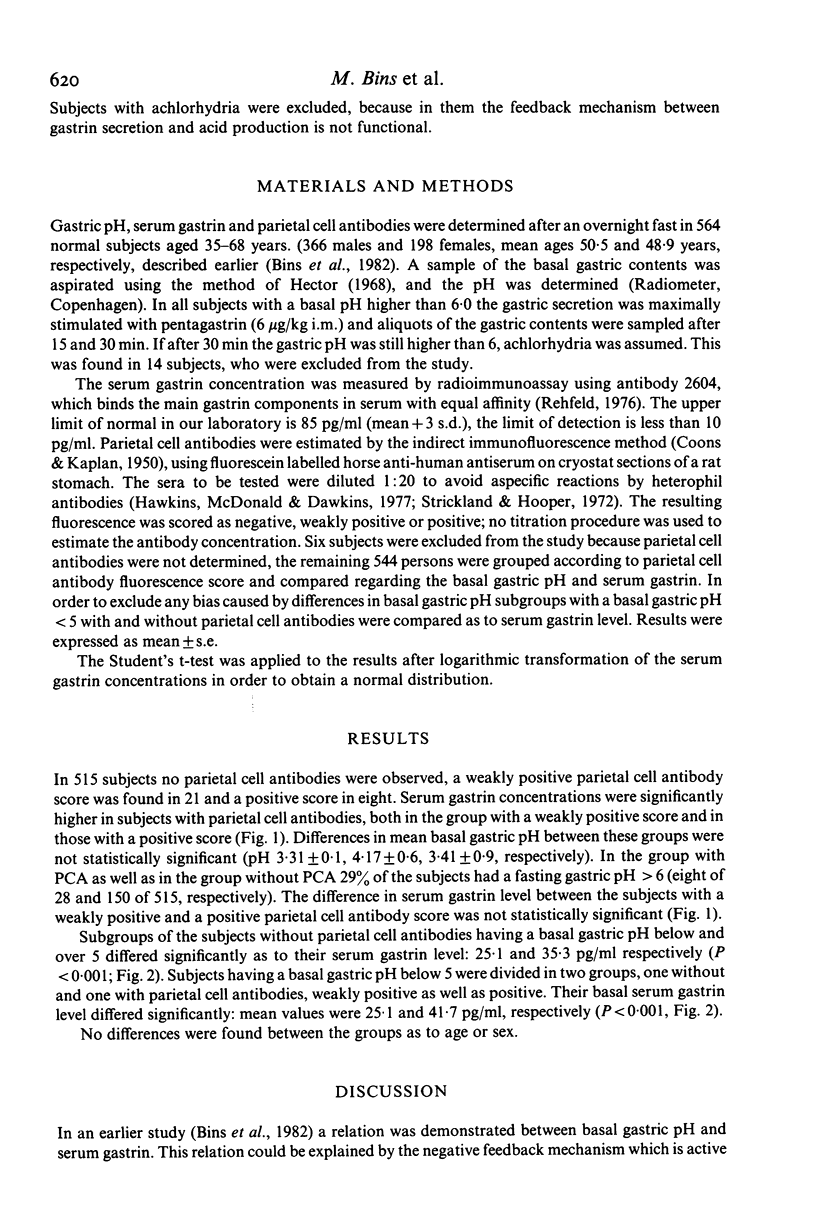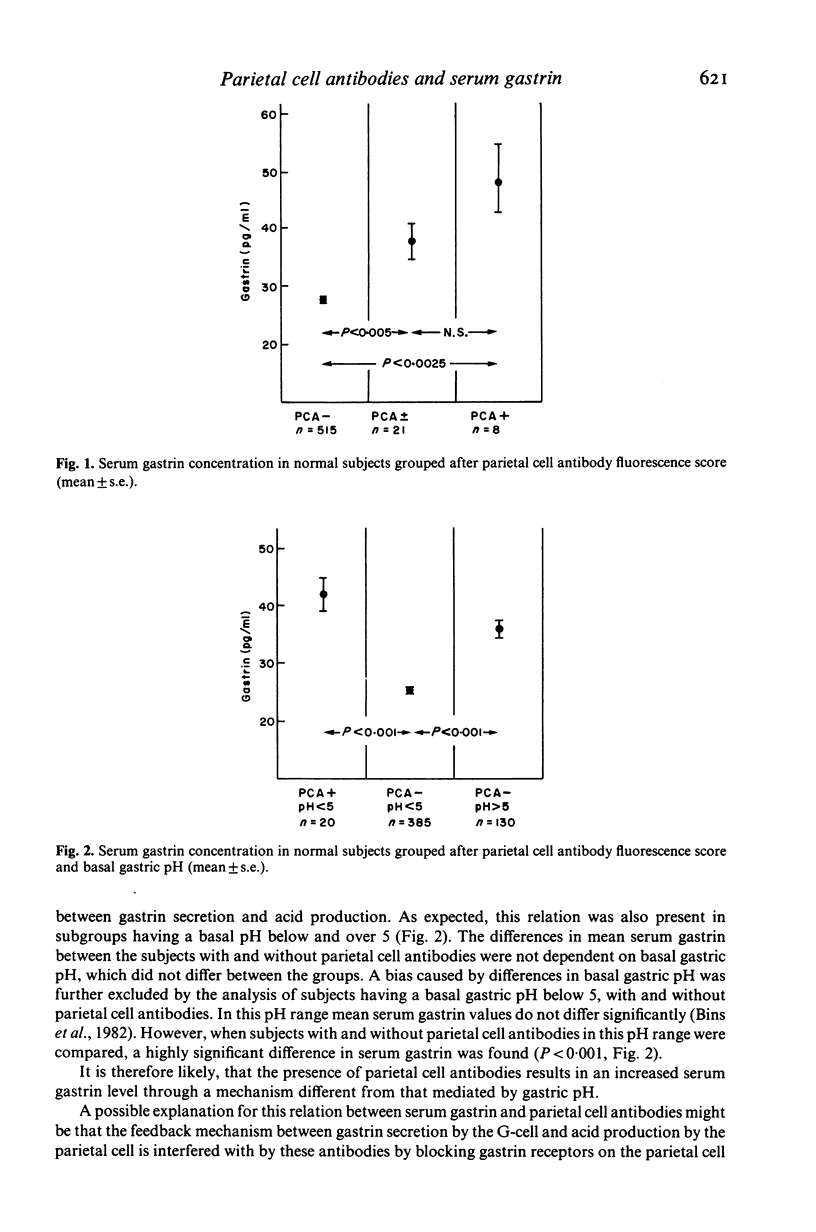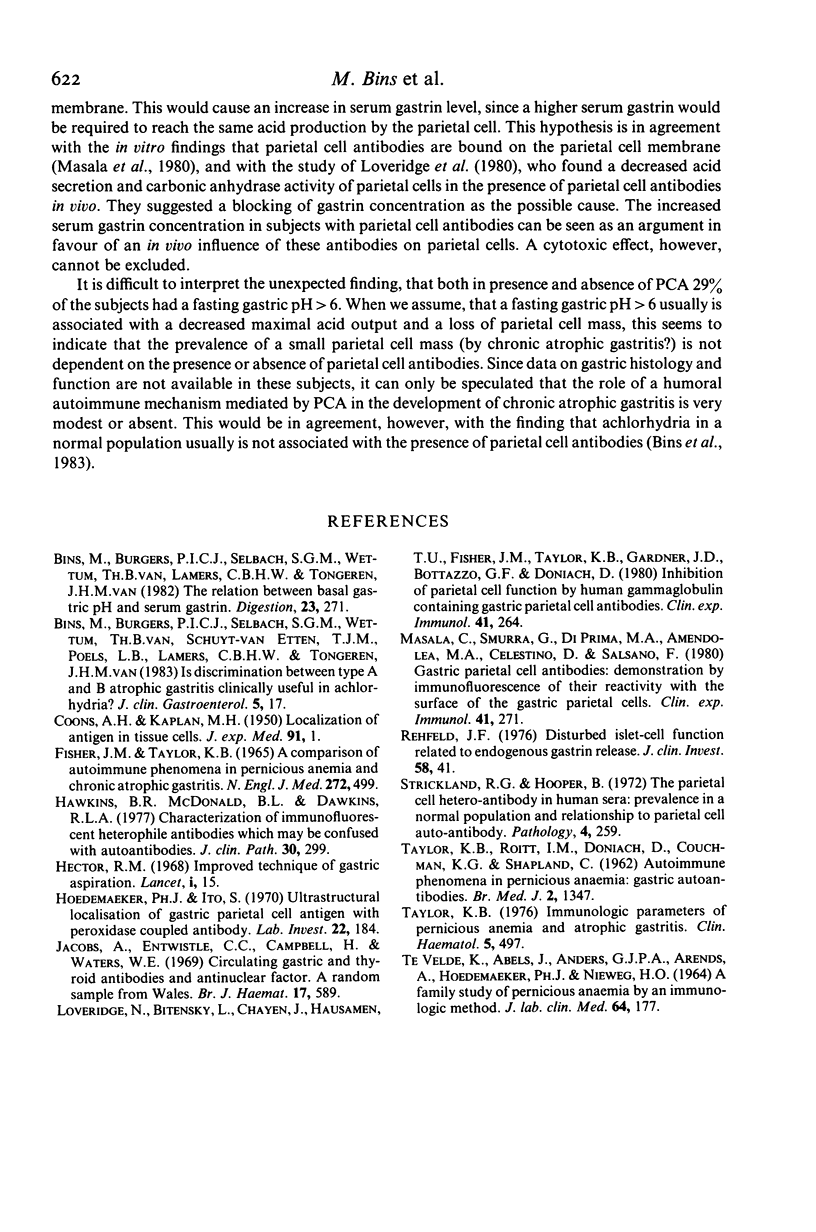Abstract
Parietal cell antibodies, basal gastric pH and serum gastrin were determined in 544 normal non-achlorhydric subjects. Serum gastrin was significantly higher in subjects with parietal cell antibodies, both in the group with a weakly positive and in that with a strongly positive fluorescence score. The elevated serum gastrin level in subjects with circulating parietal cell antibodies was independent of gastric pH. It is suggested that parietal cell antibodies may interfere with gastrin receptors on the membrane of the parietal cell, thus influencing the feedback mechanism between the secretion of acid and gastrin, and resulting in an increase of the basal serum gastrin level at an unchanged basal gastric pH.
Full text
PDF



Selected References
These references are in PubMed. This may not be the complete list of references from this article.
- Bins M., Burgers P. I., Selbach S. G., van Wettum T. B., Lamers C. B., van Tongeren J. H. The relation between basal gastric pH and serum gastrin. Digestion. 1982;23(4):271–273. doi: 10.1159/000198761. [DOI] [PubMed] [Google Scholar]
- Bins M., Burgers P. I., Selbach S. G., van Wettum T. B., Schuyt-van Etten T. J., Poels L. B., Lamers C. B., van Tongeren J. H. Is discrimination between type A and B atrophic gastritis clinically useful in achlorhydria? J Clin Gastroenterol. 1983 Feb;5(1):17–19. doi: 10.1097/00004836-198302000-00004. [DOI] [PubMed] [Google Scholar]
- COONS A. H., KAPLAN M. H. Localization of antigen in tissue cells; improvements in a method for the detection of antigen by means of fluorescent antibody. J Exp Med. 1950 Jan 1;91(1):1–13. doi: 10.1084/jem.91.1.1. [DOI] [PMC free article] [PubMed] [Google Scholar]
- FISHER J. M., TAYLOR K. B. A COMPARISON OF AUTOIMMUNE PHENOMENA IN PERNICIOUS ANEMIA AND CHRONIC ATROPHIC GASTRITIS. N Engl J Med. 1965 Mar 11;272:499–503. doi: 10.1056/NEJM196503112721002. [DOI] [PubMed] [Google Scholar]
- Hawkins B. R., McDonald B. L., Dawkins R. L. Characterisation of immunofluorescent heterophile antibodies which may be confused with autoantibodies. J Clin Pathol. 1977 Apr;30(4):299–307. doi: 10.1136/jcp.30.4.299. [DOI] [PMC free article] [PubMed] [Google Scholar]
- Hector R. M. Improved technique of gastric aspiration. Lancet. 1968 Jan 6;1(7532):15–16. doi: 10.1016/s0140-6736(68)90006-8. [DOI] [PubMed] [Google Scholar]
- Hoedemaeker P. J., Ito S. Ultrastructural localization of gastric parietal cell antigen with peroxidase-coupled antibody. Lab Invest. 1970 Feb;22(2):184–188. [PubMed] [Google Scholar]
- Jacobs A., Entwistle C. C., Campbell H., Waters W. E. A random sample from Wales. IV. Circulating gastric and thyroid antibodies and antinuclear factor. Br J Haematol. 1969 Dec;17(6):589–595. doi: 10.1111/j.1365-2141.1969.tb01410.x. [DOI] [PubMed] [Google Scholar]
- Loveridge N., Bitensky L., Chayen J., Hausamen T. U., Fisher J. M., Taylor K. B., Gardner J. D., Bottazzo G. F., Doniach D. Inhibition of parietal cell function by human gammaglobulin containing gastric parietal cell antibodies. Clin Exp Immunol. 1980 Aug;41(2):264–270. [PMC free article] [PubMed] [Google Scholar]
- Masala C., Smurra G., Di Prima M. A., Amendolea M. A., Celestino D., Salsano F. Gastric parietal cell antibodies: demonstration by immunofluorescence of their reactivity with surface of the gastric parietal cells. Clin Exp Immunol. 1980 Aug;41(2):271–280. [PMC free article] [PubMed] [Google Scholar]
- Rehfeld J. F. Disturbed islet-cell function related to endogenous gastrin release. Studies on insulin secretion and glucose tolerance in pernicious anemia. J Clin Invest. 1976 Jul;58(1):41–49. doi: 10.1172/JCI108457. [DOI] [PMC free article] [PubMed] [Google Scholar]
- Strickland R. G., Hooper B. The parietal cell heteroantibody in human sera: prevalence in a normal population and relationship to parietal cell autoantibody. Pathology. 1972 Oct;4(4):259–263. doi: 10.3109/00313027209068951. [DOI] [PubMed] [Google Scholar]
- TAYLOR K. B., ROITT I. M., DONIACH D., COUCHMAN K. G., SHAPLAND C. Autoimmune phenomena in pernicious anaemia: gastric antibodies. Br Med J. 1962 Nov 24;2(5316):1347–1352. doi: 10.1136/bmj.2.5316.1347. [DOI] [PMC free article] [PubMed] [Google Scholar]
- Taylor K. B. Immune aspects of pernicious anaemia and atrophic gastritis. Clin Haematol. 1976 Oct;5(3):497–519. [PubMed] [Google Scholar]
- VELDEK T. E., ABELS J., ANDERS G. J., ARENDS A., HOEDEMAEKER P. J., NIEWEG H. O. A FAMILY STUDY OF PERNICIOUS ANEMIA BY AN IMMUNOLOGIC METHOD. J Lab Clin Med. 1964 Aug;64:177–187. [PubMed] [Google Scholar]


